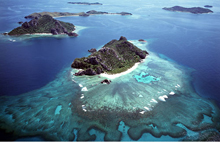Participating teams determine the priority invasive species issues and projects that they will use the network to help them achieve in their island homes.
The strategic projects identified by the current participating teams focuses on the invasive species strategic planning process. By mid-2008 the network had supported 7 PILN teams to initiate this process, and 3 of the resulting plans have received official endorsement. Two other common themes for the strategic projects are regional collaboration for improved border control, and public awareness of the risks posed by invasive species, from community to government level.
Field priorities are varied, reflecting the range of problems being addressed in the region.
Priority invasive plants:
- Strawberry guava, Psidium cattelianum, Wedelia trilobata, Antigono leptopus, Merremia peltata, betel nut Bud Rot, Phytophthora palmivora
Priority invasive vertebrates:
- Myna birds, brown tree snake, Boiga irregularis, rodent eradication and control (both rats and mice), multi-species management
Priority invasive invertebrates:
- Giant African snail, Achatina fulica, yellow crazy ant Anoplolepis gracilipes
At the first Meeting , teams exchanged experiences, started to formulate lessons learned, identified where expert exchanges would be useful and drafted action plans for each project.

Most of the terrestrial biodiversity in the Pacific is found on high islands. Monu and Monuriki Islands, Mamanucas, Fiji. © Stuart Chape.

Invasive vines are a big problem in many Pacific islands.